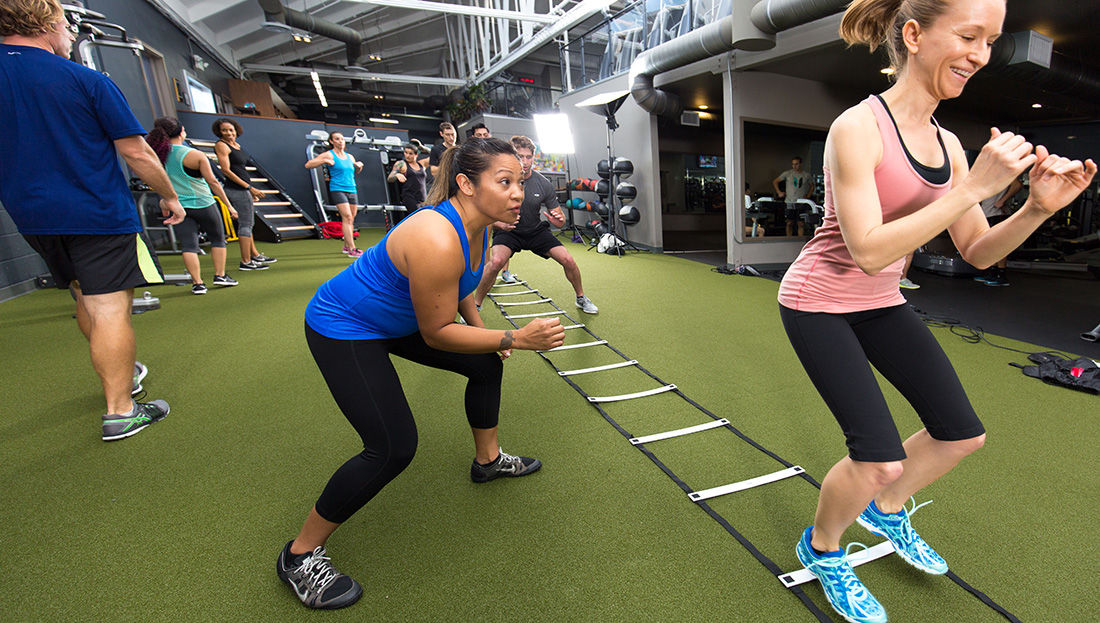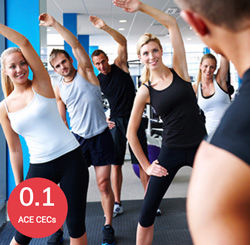
Fitness instructors are usually hyper-aware of how their appearance, clothes, music, posture and physicality influence participants’ impressions and experiences during class. But we tend to devote less attention to carefully planning and reflecting on our actual words and tone. This article isn’t about cueing; it’s about the positive and negative messages we convey through word choice.
Why Do Instructors’ Words Matter So Much?
The way you speak about fitness can shape your participants’ perceptions of exercise and even themselves.
“Words, in any situation, have meaning,” says Shannon Fable, IDEA and ACE Instructor of the Year and executive vice president of Learning and Product Development at FIT4MOM Franchise in Boulder, Colo. “Not only do words allow you to successfully execute moves, drills or choreography, they hold weight with what emotions you attach to the activity.” What’s more, anything you say is literally amplified through a microphone, making your words all the more powerful.
“The language we use is critical, whether it is our greeting to open the class, our trademarked ‘four more reps’ or the nonchalant comments we make as we offer a physical adjustment,” says Lashaun Dale, MA, MPH, fitness instructor, vice president of Content, Programming and Media for 24 Hour Fitness and editor-in-chief at 24Life in Whitefish, Mont. “What we say matters and creates the context for our students’ emotional and physical success. Language creates worlds in our minds. We want to create worlds that give our students possibilities and not limitations.”
Unfortunately, well-meaning instructors may inadvertently discourage some participants when they mean to do quite the opposite. Even seemingly innocuous comments such as, “Let’s get in shape for summer!” or “This is the beginner version of the exercise,” might trigger a cascade of difficult associations and emotions for some people. Meanwhile, other participants might say they find it helpful and motivating.
“Words have the power to lift someone up or bring someone down,” says Ryan Halvorson, fitness industry writer, editor and consultant in San Diego, Calif. “And in an environment that is already steeped in trying to ‘fix’ something—weight, mood, health, etc.—the last thing class participants need is to feel more uncomfortable than they already do.”
How do you know for sure what might make someone in class feel uncomfortable? You don’t. But you can take an educated guess and select your words carefully.
“If the words and communication we use toward our participants are interpreted as negative, that could ultimately lower the individual’s confidence and they may no longer come to our classes or even participate in physical activity,” says Ben Kohler, MS, group fitness coordinator at the University of Minnesota and master educator for Stages Indoor Cycling™ in Minneapolis.
When it comes to communication, there’s sometimes a fine line between intention and interpretation. Instructors must somehow navigate the minefield of word choices that could either elevate people or bring them down. Success in this area starts with an awareness about what you actually want to say, why you want to say it and how you go about it.
Bringing Up Body Image
The language around body image and fitness is a hot topic. It's been a long-standing tradition for instructors to reference “bikini bodies,” “flat abs” and “jacked arms.”
Not surprisingly, research supports what a lot of fitness pros already know anecdotally: Wording related to exercise affects body image. In a recent study published in the Journal of Clinical Sport Psychology, researchers found that female class participants reported greater body satisfaction and improved mood when an instructor’s motivational comments related to strength and health versus appearance and weight. Additionally, those subjects who participated in a class with messaging related to function described their class in more positive terms than those who worked out with an instructor who used appearance-focused language (Engeln, Shavlik and Daly, 2018).
“We think a student will turn the indoor-bike dial over a few notches when we say things like, ‘The greater the resistance the better those thighs will look at the beach,’” explains Halvorson, “but in my opinion, it pushes [them] into a negative state of being in that now they must work hard because the thighs that are helping turn the pedals are unsightly.” Even if such a cue pushes someone to work harder, it stems from negativity. “I prefer to create a space that does not highlight perceived flaws,” he says.
Besides, you’re not telling participants anything they haven’t already worried about before. For example, my master’s thesis research looked at body image and the role of the fitness instructor (Vogel, 1998). Interviews with female fitness participants revealed that some women laughed off an instructor’s image-conscious comments, admitting it made them work a little harder; however, others found these comments discouraging.
“I think we’re all very aware of our weak spots,” a 52-year-old participant named Pat told me, adding, “I don’t need to be reminded how ugly my legs look in a swimsuit. I know that already.”
It’s always better to play to people’s strengths than their insecurities. And that goes for the very notion of exercise, too: Your wording sets up exercise to be either positive or negative. “Cues like, ‘Let’s take it up a notch so you can indulge in a glass of wine’ position exercise as a means to an end,” says Fable. “They reinforce that exercise is used to ‘fix’ something. Exercise, and the words we choose to instruct, should be used to celebrate our bodies and focus on the feeling exercise provides.”
Suggesting Progressions, Regressions and Modifications
An instructor’s word choice can also play a large role in how participants view their own capabilities and even the exercises they perform. While you’ll want to provide participants with multiple options that progress an exercise from less to more advanced, you probably wouldn't want to frame it that way with your language.
Participants are quick to translate the word “intense” as “better.” And anything that’s “easier,” “beginner” or even sometimes “low impact” must imply it’s less than the hard, high-impact move, right? Where do participants get these ideas? Sometimes it’s because instructors demonstrate the exercise they want people to do then say, “If you’re a beginner, modify like this” or “If you can’t do that, try this.” Few people want to appear as if they can’t do what everyone else is doing.
“One of the most interesting topics currently facing instructors is the language around modifying an exercise,” says Kohler. “We have a few options when it comes to articulating modifications. We can refer to them as modifications, options, progressions and regressions. We [have the] challenge of providing participants with a version of the exercise that feels good for them, but the impact could be that they are not ‘good enough’ to perform the exercise you planned, so therefore they must choose a different one. We have to find the line where we offer different versions of exercises, but delivery is key.”
“Even the word ‘modification’ can send some participants into a negative place,” says Fable. “While I understand that many instructors do not see the harm in using these terms, I would also suggest we’ve never quite been in a place to question how these labels might sit.” Fable says her perception of words such as beginner, intermediate, advanced and modification changed when she attended a fitness class for the first time after a pregnancy that required a long bout of bed rest. “Every time I had to take the modification, I felt my confidence fade,” she says.
One possible way to skirt around the “modification” label is to simply offer choices or options, making it more difficult for participants to determine which move is “the one” and which is a modification. In fact, it helps to view all the options as equal but different so you don’t slip into wording that suggests otherwise. Presenting people with “choices” also neutralizes any judgment related to beginner, intermediate or advanced, especially when some people who require a less-intense exercise for various reasons would never identify as “beginner.” Fable says this would have made a positive difference to her class experience post-pregnancy. “I would have felt much better if the options were simply presented as that: ‘you could do this or that,’ ‘whichever works for you,’ or ‘it’s your choice.’”
Teaching Exercise Technique
It's tempting to tell participants what not to do when teaching exercise technique, but this terminology could set the wrong tone.
“Using words that help participants look for ‘clues’ as to whether or not they’re getting it right goes much farther than telling them what not to do,” says Fable. For example, she suggests avoiding cues such as, “Don’t drop your chest in the squat.” Instead try, “Look in the mirror—you should be able to see a proud chest staring back at you.”
“It’s all about cueing optimal form in simple ways and reminding students of what a movement should look like or feel like,” says Halvorson. Cuing in the form of questions helps keep language positive, he adds. For example, during squats, ask the group, “Are your shoulders back and down?” or “Do you notice even weight in both feet?”
“An effective cue needs to be concise, intentional and positive,” says Kohler. “Use the least amount of words possible, make sure that you are not just filling space or airtime, and frame it in a positive way!” Most of all, avoid belaboring an explanation when folks just aren’t getting the technique you want. “If they can’t change it in 10 seconds, don’t bring it up, and [instead] follow up with them after class.”
Additionally, Dale recommends choosing a tempo and a vocal quality for your instructional cues that are slightly different from your motivational cues. “This will signal their attention,” she says. When people pay attention, it increases their ability to get the right technique.
Word to the Wise
When class is over, you want participants to walk out the room feeling successful, uplifted and good about themselves! There are numerous factors that play into that outcome—and you can be sure that thoughtful word choice is high on the list. “Expect that what you say and the connection you make with your students before, during and after class (and on social media!) will be carried with them for at least the rest of the day,” says Dale. “Use your words wisely.”
Talking Tips to Try in Your Classes
Every good instructor has a few tricks for elevating the class experience through word choice and messaging. Here’s a roundup of talking tips to try from expert group instructors.
“Choose aspirational words such as, ‘healthy,’ ‘strong’ or ‘athletic’ to motivate. I end each class with all participants taking a deep breath together. I say, ‘Remember that you are strong and healthy’ and wish them a wonderful day (or evening).”
—Kristen Horler MS, CEO and founder of Baby Boot Camp, Sarasota, Fla.
“Make it about the process, not the outcome. Paint a picture with your words about what you want students to do in the present, not what you want them to achieve in the future (e.g., create space between your shoulders and your ears; imagine a string on the crown of your head, pulling you straight up). ‘Bikini booty’ or ‘six-pack abs’ are outcome-oriented and not necessarily an outcome the student cares about achieving.”
—Leigh Crews, TRX Senior Master Course Instructor, IDEA 2011 Fitness Instructor of the Year, Cedar Bluff, Ala.
“Positive cueing—e.g., you are stronger than you think—helps you push people to succeed. Here’s a script I use in class: ‘Think about a time when you thought you couldn’t do something—a project that seemed too big, a hill that seemed too steep. Then think about how you felt when you got through it. You don’t have to be great all the time, but anyone can push through 60 seconds to a better version of themselves.’”
—Erin Phelan, group fitness instructor at Equinox and health coach, Toronto, Ontario
“Focus on how moving your body can impact the immediate moment, such as boosts in mood, energy levels and feelings of accomplishment. Use language in class such as ‘Think of how much energy you will have now to get through the day,’ or ‘Let's get our boost of happiness today,’ or ‘Let's grab that feeling of accomplishment and finish strong,’ etc.”
—Dr. Cherie Pettitt, owner of Elevating Exercise Science, Salt Lake City, Utah
“Our words carry a lot of weight so when we use our words, they come with energy. We will only be remembered in one of two ways: positive or negative. To create positive energy, I like to say something like, ‘As long as one of us is having a good time in this class, it’s a success, and I’m having a ball!’ That usually gets a good laugh. Laughter keeps people going and makes them forget about the pain. Mind and body work best when they work together.”
—Marc Coronel, Coach Creator, personal trainer, Under Armour Training Team, Las Vegas, Nev.
“Make eye contact and feel the motivation in your body as you deliver your words. It seems counterintuitive in a group setting to offer motivation to one person at a time. However, it is exactly what allows you to connect to everyone in the class. The more direct, the more we can connect.”
— Lashaun Dale, MA, MPH, fitness instructor, vice president of Content, Programming and Media for 24 Hour Fitness, Whitefish, Mont.
“Record yourself—not video, audio. Then listen back. Listen for silence. Listen for clarity. Listen for your ticks. Listen for your intonation. How do you come off without the energy of the room and the power of your presence?”
—Shannon Fable, fitness industry business and programming consultant, Boulder, Colo.
“I always start and end class with either a goal-setting or ‘success-setting’ intention/reflection. Simply stating, ‘What will make you feel successful today?’ allows participants to define what is successful for them.”
—Ben Kohler, MS, group fitness coordinator at the University of Minnesota, Minneapolis
“Avoid aesthetic-based cues no matter how positive you think they are. Focus instead on movement mechanics and feelings. Emphasize what people are doing well instead of how they’re failing.”
—Ryan Halvorson, fitness industry writer, editor and consultant, San Diego, Calif.





 by
by 




